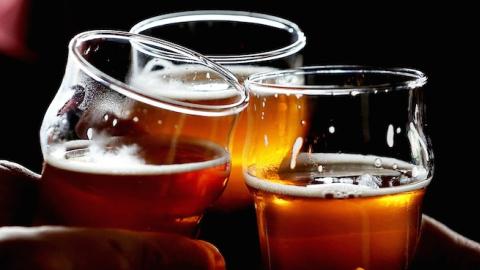It’s a remarkable weekend when one finds the Grey Lady arguing for states' rights, and worrying huffily about arbitrary Presidential powers. But when it comes to smoking dope, the mind of the New York Times has fully boggled. Against careful science, sound public policy, and even liberal politics that defends the vulnerable, the venerable editors have decided that what America needs now is marijuana, and more of it.
Without a change in federal law, they write, citizens would be “vulnerable to the whims of whoever happens to be in the White House, and chooses to enforce or not to enforce the federal law.” No, they are not talking about the current occupant, who rules like the Red Queen. They are worried that some future president might enforce the law against the trafficking in toxins. Entranced by the specter of Al Capone, the Times embraces the wrong-headed idea that marijuana is less dangerous than alcohol. There are two problems with this belief: it’s terribly dated. And it is contradicted by any serious consideration of the facts.
One rarely hears a plea for greater marijuana access based solely on an evaluation of its likely impact on public health or crime rates. Instead, there is almost always a pairing with alcohol, a sophistry that makes marijuana appear more safe. The argument’s pairing is revealing. Alcohol, legal for adults, is very widespread, and deeply entrenched in Western history. Marijuana, as a significant substance of use is recent by comparison, and has only a fraction of the prevalence, a fact surely attributable to the disincentives for use contained in its prohibition. The harms of marijuana are controlled by its prohibition and can only be expected to grow rapidly by making marijuana use on a par with alcohol use.
This discussion reveals two things. First, there is a missing argument in the comparison trope, which is that it’s not really about the respective safety of the substances, but about their disparate legal treatment. Drinkers get to enjoy their intoxicant, while marijuana smokers have to fear arrest. This injustice should be rectified by letting marijuana users have their drug under the same terms as alcohol. As we see, if one can’t make a compelling case for marijuana on its merits, at least one can denounce alcohol, cry hypocrisy, and expect parity.
To be fair, there is some measure of academic support for the position concerning alcohol. Professor David Nutt, the former chief drugs advisor to the United Kingdom, published his rank-order of harmful substances in the journal Lancet, in 2010. He claims that in terms of costs to society, alcohol does the “biggest harm.”
Nutt calculated two scores, the “harm to users”, and the “harm to others” based on 16 criteria he developed, and alcohol was the “overall” worst. But what are we to make of the non-obvious realization that, according to Dr. Nutt, alcohol is more damaging than either heroin or cocaine?
Clearly the rankings are being affected by the number of users, which contribute to the overall calculus of “disease burden” for any affliction. Seasonal flu is more common than leprosy. Shall we argue that getting the flu is “worse” than getting leprosy? The same phenomenon affects our alcohol comparison. There are roughly six times as many regular drinkers in America (120 million) than regular users of marijuana (about 19 million), and the damage is a function of these dimensions.
The usual rhetorical trump card for marijuana supporters, however, is the issue of overdose deaths. Excessive alcohol consumption kills. And while deaths from a lethal dose of cannabis consumption do exist (usually cardiac issues), they are rare, and direct lethal toxicity for THC, the psycho-potent ingredient, is widely discounted. (But if dose-lethality were driving public perceptions of harm, it’s hard to understand the posture towards tobacco; a lethal dose of nicotine is possible, but poisoning is found mostly in its use as a pesticide, not common smoking, yet tobacco is widely seen, quite correctly, as a devastating substance.)
That said, though alcohol is a contributing factor to American deaths numbering in the hundreds of thousands, overdose deaths are not as common as might be supposed. They number a bit over 300 per year, considerably lower than deaths for opiates (about 16,000), but outpacing any claims for cannabis.
Lethality aside, it is difficult to see the immediate consequences of cannabis consumption as benign. Marijuana is the second-leading drug-related reason for a visit to a hospital emergency room, trailing only cocaine. In fact, with about 450,000 emergency room mentions a year, marijuana now exceeds heroin. Most commonly, someone consumes too much, has an adverse reaction, physiological or psychological, and goes for help.
A central point is that virtually everything that the New York Times thinks they know about marijuana's effects is based on old anecdotes (including personal experimentation), cultural perceptions, and in some cases, even legitimate research derived from a time when marijuana was, on average, one-fifth to one-sixth as powerful as it is today. To compound the threat, the mean age for initiating marijuana use today is 18, with a substantial number of 12-15 year-olds starting every year. They are at an even greater developmental risk than the older, young adult initiates of the past.
In fact, and very worrisome, even the longitudinal literature tracing the impact of marijuana in young lives, including that research showing negative psychological impact or permanently reduced cognitive performance, is based on youth cohorts smoking the low-potency marijuana of their time. Given the rapid spread of today's highly potent varieties and the steeply increasing prevalence rates of youth use, we are facing a new and troubling prospect.
We won't really know what potential crisis we have already sown in this emerging generation of youth for at least a decade. At which point, if marijuana is as dangerous as many fear, nothing can be done but rue our negligence, and try to mitigate the damage. In terms of today's debate, however, it cannot be stressed enough. If you don't have command of the research outcomes from the last 10 years of biomedical literature on marijuana, you've no idea how threatening the potential really is.
There is a central citation in the argument concerning the relative dangers of marijuana compared to other addictive substances. It is one almost universally cited by those seeking to downplay marijuana's harms, and seems almost to be the one essential finding that they all rely on. One finds it in statements from UCLA Professor Mark Kleiman (“Roughly one in ten people who try marijuana become dependent”), and even the current Acting Director of Drug Control Policy in testimony before Congress. (“Research finds that approximately 9 percent of marijuana users become dependent.”)
The research is based on a survey, and compares self-reports of alcohol, tobacco, and use of various drugs, in relation to the risk of dependence on those same substances, as measured by diagnostic criteria. Sure enough, we are gazing at twenty year-old cannabis studies, the year of publication being 1994. Once again, let us ask the same reliability question: what do reporters think that the research says, and what does the research actually say?
Let’s take a common formulation of the purported results. In Forbes magazine, we read, ”According to one widely cited study, based on data from the National Comorbidity Survey, dependence is nearly 70 percent more common among drinkers than it is among pot smokers. So even by this measure, marijuana looks less dangerous.”
Granted, the research in question does contain this outcome. In fact, they have a rank order of substances of abuse in terms of the proportion of users who display dependency, with tobacco leading the pack, as it were, followed by alcohol and only then, cannabis.
Specifically, they report that a history of prevalence compared to a history of dependence in their study population the ratios are, for tobacco, of users, one in three shows dependence. For alcohol, it’s one in five showing dependence, while for cannabis, it’s only one in nine dependent.
Were we to interpret this finding as though it were, in reality, a measure of the dependency-producing risk in using a substance as a function of the addicting quality of that substance, we would see them in this rank order with tobacco followed by alcohol, and only then cannabis.
One would think that cannabis is thereby shown to be "safer" than either tobacco or alcohol. That seems to be the interpretation journalists and advocates grasp and propel forward. But is this the proper way to read the research?
Anyone reading closely will find reason for caution in making this interpretation. First, there is a question about what researchers call the "prevalence category" of those self-reporting their use – what is their use rate over time? They were reporting their "lifetime" use history, and their "lifetime" dependence history.
That means this study population catches those who have ever used a substance, even once. Some may use regularly, but many are simply those who tried a substance perhaps once in youth, or perhaps once a year for a couple of years. Such a measure is not the prevalence category that enables us to arrive at the conclusion which we are encouraged to arrive at, which is the question of whether repeated, continuous exposure—say weekly or monthly—to the substance in question itself leads to the habitual deepening of use which characterizes dependency and addiction.
In order to make that inference, one would need to examine current or past month use, or have data on daily use of the substance. Of course, were that the prevalence category, the number of people in the study population who would meet these criteria would plummet sharply and weaken the reliability of any conclusions.
There is further reason for caution. The study did not stop with cannabis, but went on to examine lifetime exposure to a large variety of drugs in comparison to their dependence profile. The next drug on the list is cocaine. And the figures for cocaine are that 19.5 percent of the study population has used cocaine in their lifetime, with 3.5 percent showing dependence. This should trouble us.
We appear to have just proven, under the standard interpretation, that alcohol and tobacco are more addictive than crack. Because in this rank order only 1 in 6 cocaine users show dependence, we must conclude that cocaine is "safer" than tobacco and alcohol, as well. That would be news.
Or, more realistically, it demonstrates that we have fixed on the wrong interpretation of the study's findings. One cannot conclude from these figures anything reliable about the respective "dangers" of the substances themselves, taken in isolation, as potentially dependency-producing drugs. Nor does the original research make that claim. In fact, the researchers are well aware of the potential limitations of these results, and explicitly discuss the complexities they present.
As they write; "The array of interrelated factors includes relative drug availability, and opportunities for use of different drugs as well as their costs; patterns and frequencies of drug use that differ across drugs; different profiles of vulnerabilities of individuals … as well as both formal and informal social controls and sanctions against drug use or in its favor…. Considered all together … the transition from drug use to drug dependence runs a span from the microscopic (e.g. the dopamine receptor) through the macroscopic (e.g. social norms for or against drug use; international drug control policies).”
When this position is understood, we see that, if anything, it is an argument cutting against the policy of marijuana legalization. Both tobacco and alcohol are legal substances, and have use rates multiple times in excess of (illicit) marijuana. Moreover, they are used in patterns that make exposure to them considerably in excess of exposure to marijuana. Those who smoke tobacco do so multiple times a day, commonly every day; in relative fashion the same holds true for alcohol use.
And this research specifically notes that it is just such patterns of access, frequency, and persistence of use that contribute to the overall dependency-producing potential, in conjunction with the biology of the substance itself in relation to the brain. Simply put, were marijuana (or cocaine) to be legal, and subject to comparable access and use patterns by subjects on a daily basis, the impact on their dangers as found in dependency and addiction rates, while unknown, would likely be staggering.
Asking whether cannabis is "safer" than alcohol is in reality not a useful research question, even under the best of measurement conditions. They are different, and each produces a distinctive risk profile, distributed across differently situated persons. It is not productive to ask whether breast cancer is "worse" than heart disease; they are each of them diseases with distinct dangers, populations, and consequences.
No one is trying to underplay the dangers to be found in alcohol consumption. It's a substance with known risks and exorbitant costs. But to argue that because alcohol is dangerous, therefore we should admit cannabis, the true risks of which we are just discovering, into the same regulatory regime of access and use, is certainly not justified by the actual research. Moreover, the pervasive reportorial neglect, ignorance, and distortion concerning marijuana are, at best, unprofessional.
To close, the culture-war value of marijuana, it can be argued, has distorted our understanding of the true risks. Though I have decried the datedness of some citations, I can find no more compelling demonstration of the impact of the counter-culture on our understanding of this drug than by resorting to even earlier research. Specifically, I summarize the testimony of two researchers called before Congress forty years ago, when the counter-culture was only starting to shape American institutions. Much has been learned about THC in the intervening years but even then it was apparent to the medical experts that the comparison to alcohol was misleading, and that treating them both under a comparable regime of legal access does a disservice. Though much has changed in our understanding, that essential message is even more important and telling, today.
“Alcohol… is eliminated in a few hours, there is little or no evidence for carcinogenicity or teratogenicity [producing abnormalities] … psychotic phenomena only occur after heavy and prolonged dosage … it escalates only to itself; the price paid for overuse is paid in later life. Cannabis is taken specifically for its psychic action; it is cumulative and persistent; its tar is carcinogenic … experimentally it is teratogenic; psychotic phenomena may occur with a single dose; it can predispose to the use of other drugs; the price for its overuse is paid in adolescence or in early life.”
“Brain activities in relationship to these compounds are drastically different. Alcohol does not … directly and profoundly affect brain function as the cannabis preparations do…. You can use alcohol for a long period of time without producing any sort of persistent damage. But with marihuana … it seems as though you have to use it only for a relatively short time … before (it) produces distinctive and irreversible changes in the brain.”
As disturbing as this testimony is, forty years ago the average THC potency of marijuana in the U.S. market was less than 3 percent, compared to the 13 percent of today’s drug. Recent research suggests that even casual use, among young adults, produces brain anomalies in structures required for reward and emotional processing. It cannot be stressed enough: virtually every month major research findings are confirming the impact of THC as a neurotoxin with no safe dose; the cumulative literature is becoming inescapable. Marijuana use changes the brains of users, and the more and earlier they smoke, the more comprehensive and lasting the potential damage. A causal argument is not yet made, but neither is it required for prudent public policy action. There is now sufficient evidence to establish that we are putting our children – all our children, including the minority and the vulnerable -- at risk by increasing access to a poison.
Currently, of young adolescents who use marijuana, some 6 percent are daily users. The cumulative, persistent effect of such exposure on adolescent human subjects, the brains of which are in critical phases of development, is simply unknown. The research indicates the likelihood of even greater dangers in marijuana use today, as we move to expose more Americans to its use. There has seldom been a more foreseeable health catastrophe.





















